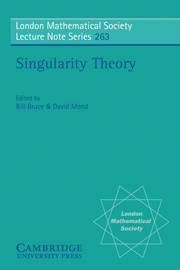 Singularity Theory
Singularity Theory Introduction
Published online by Cambridge University Press: 05 May 2013
Summary
We start with a rapid survey, which we hope may be of some use to non-experts.
Singularity theory is a broad subject with vague boundaries. It is concerned with the geometry and topology of spaces (and maps) defined by C∞, polynomial or analytic equations, which for one reason or another fail to be smooth, (or submersions/immersions in the case of maps). It draws on many (most?) other areas of mathematics, and in turn has contributed to many areas both within and outside mathematics, in particular differential and algebraic geometry, knot theory, differential equations, bifurcation theory, Hamiltonian mechanics, optics, robotics and computer vision.
It can be seen as a crossroads where a number of different subjects and projects meet. In order to classify its current diverse productions, we centre our discussion around the contribution of five major figures: Whitney, Thom, Milnor, Mather and Arnold.
The first of these to work on singularities was Whitney, who was led to study singularities in the process of proving his immersion theorem. An n-manifold M can be immersed in (2n – 1)-space, even though immersions are not dense in the space of all maps M → ℝ2n–1: singularities persist under small deformations. To remove them one needs a large deformation, and a good understanding of the singularities themselves.
- Type
- Chapter
- Information
- Singularity TheoryProceedings of the European Singularities Conference, August 1996, Liverpool and Dedicated to C.T.C. Wall on the Occasion of his 60th Birthday, pp. ix - xivPublisher: Cambridge University PressPrint publication year: 1999
